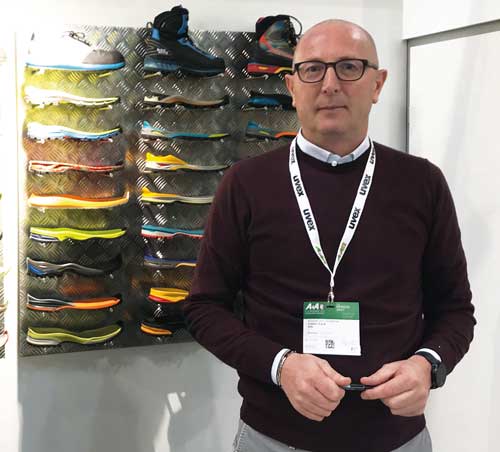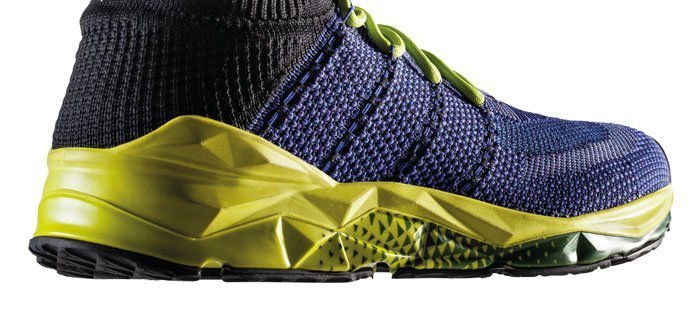
A company boasting over a century of experience: it can rest on its laurels, or so one might expect. This is not Frasson’s case, company headquartered in Treviso province that, in the last few years, has chosen to expand its scope of action by turning its attention to the safety footwear sector.
Thanks to an unrivaled know-how, to a groundbreaking technical and technological expertise as well as to a solid network of partnerships with manufacturers and customers, Frasson has pointed out the potential of a fast-growing field, making the most of the long-standing experience acquired in the outdoor sector. As confirmed by the firm’s owner, Gianni Frasson.

Gianni Frasson
The workwear market is experiencing a significant development worldwide. Is it the same for footwear? Definitely. Given that there are regulations to comply with, this market has been growing steadily. Besides that, everybody, manufacturers and consumers alike, has noticed that the quality of safety workwear has a positive effect on people’s wellbeing, regardless. A trend confirmed by the fact that the most prominent players have been investing in research and technology applied to work footwear. We are no longer at a “basic” level – that is, drab safety models, with no attention whatsoever to style -, now finely-crated solutions are in high demand, just like in the sports footwear sector. One of the ultimate goals is to guarantee the wellbeing of people that, by law, have to wear this type of shoes for several hours a day.
How long have you been working in this sector? We were a bit late, yet still in time to understand that there are plenty of interesting opportunities. It was easy enough to fall into step with this sector’s requirements and to adjust the experience acquired in the outdoor industry. Customers have supported this choice, thus resulting in a fruitful collaboration; we have developed a solid professional network and we are reaping the benefits of this strategy. There are ample margins for growth and development.
What market segment does Frasson belong to? Definitely in the technical and high-end market; as a matter of fact, when it comes to soles, we use mainly rubber and polyurethane. We design soles and wedges for a clientele on the lookout for first-rate performances and maximum comfort.
Shoes featuring an injected sole and lasted shoes. Will one solution prevail over the other? Direct injection onto upper is still the most widespread system, yet several manufacturers have been adding to their collections lasted models, conceived for a more demanding clientele. On the other hand, innovation has gone a long way: for example, our articles do not need glue – the coating, drying and reactivation processes slow down production -, because there is already a bonding film, called EcoBond, that is, a system that simplifies the operations: you can take the sole out of the box, put it on the conveyor and glue it directly. Some developments are set to utterly change the product in both sectors.
There was some talk of new technologies such as chips implemented on shoes, fall-arrest systems, GPS, and much more. There are plenty of rumours concerning these solutions, but, to date, nothing concrete has come out of it. The technology is already available, it will be easy enough to implement it. We are still in the early stages, but, maybe, in the future, the use of these devices is going to be compulsory. Chips are no longer very expensive, the same goes for GPS. I would not be the least bit surprised if, one day, we would wake up and find out that the aforementioned technologies have become mandatory elements for safety shoes.
Your company is headquartered in the Veneto-based footwear cluster: what are the benefits of this location? The importance of a network of specialized enterprises is directly proportional to the complexity of footwear designing. A basic project takes approximately 40 components: therefore, 40 companies involved on average. Let’s make an example: a shoe factory submits an urgent project, for a model to be showcased at a prominent trade show: if just one of the players involved experiences some delays or acts the “prima donna”, the project is put at risk, thus jeopardizing the work of the other 39 enterprises. By working with a network of nearby firms, grown into true partners, we protect ourselves from these issues. Hence, it is imperative to join forces, to give life to a district, not only production-wise but also in terms of skills and expertise.
www.frasson.com
AN INNOVATION-DRIVEN CENTURY
The starting point was a carpentry workshop. In 1918, Antonio Frasson opened in San Martino di Lupari a workshop for the manufacturing of wooden clogs, with the support of the family: a small-sized business that, year after year, managed to gain success not only on a local level, but also nationwide, by adding to the product portfolio other wooden articles as well.
The turning point came in the ‘70s, thanks to Arduino Frasson: the core business shifted from wood to soles in composite materials, thus turning the attention to the technical footwear sector. It was the first step to innovation, followed, in 1996, by the investments in the necessary polyurethane processing technology. Frasson continued to focus on technical and technological research so as to manufacture increasingly high-performance soles, while allocating resources to the opening of new production facilities: as a matter of fact, in the 2000s, the company could count on sites based in Treviso province, Udine, Croatia and Romania. In 2008, the Multifunction patent, that is, an innovative sole that increases the slip resistance rate, was filed in 2008, later licenced to Vibram. On the other hand, the takeover of Rubbermac, firm based in Udine, took place in 2013: two years later, in 2015, said company launched the Weave technology, resulting in a 20% weight reduction for technical rubber soles. In 2018, the enterprise, now led by Gianni Frasson, celebrated its 100th anniversary: on the occasion of such an amazing milestone, it developed the new “R18 Centenario” running sole, the perfect embodiment of the know-how and technological expertise acquired over the years.
Today, research and innovation go hand in hand with sustainability, according to a corporate philosophy aimed at supplying soles that manage to both enhance people’s wellbeing and to safeguard the environment. The elimination of chemicals, investments in research projects concerning recyclable materials, transportation chain reduction at a maximum range of approximately 500 km, optimization of the whole supply chain.

